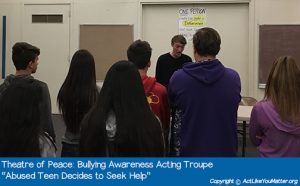Last week, Theatre of Peace: Bullying Awareness Acting Troupe performed at Santana High School. Our partner Interactions for Peace (“I4Peace”) invited us to perform The Tunnel of Bullying during Santana’s Peace Week, which is held the first week of every March.
Every time Theatre of Peace (“TOP”) goes to a school, we have the opportunity to connect with those students and demonstrate tools and strategies they can use immediately if they are a target or witness of bullying. It’s always a moving experience for both our student actors and the student audiences we perform for. But, there’s something especially meaningful about performing for the entire Freshman class at Santana High School in Santee, CA, during the first week of March.
A Very Brief History of Santana
On March 5, 2001, a Santana High School freshman named Andy Williams arrived at school with a gun and killed two students: freshman Bryan Zuckor and senior Randy Gordon. Then, he went on to injure 13 others, most of whom were also students.
Why?
The only person who will ever really know the answer to that question is the boy – now an adult – who perpetrated the violence. However, based on the research we did before we performed at Santana, there’s evidence to suggest that the 15-year-old shooter was constantly bullied by the group he hung out with and was trying to prove to them that he was tough. He’s now serving 50 years to life in a California prison.
Several Positive Things Came from the Events at Santana
In response to the shootings, Santana High School established a Peace Council – a group of students, led by teacher Angela Smith – which focuses on improving student relationships, reducing incidents of bullying on campus, and coordinating Peace Week the first week of every March.
I4Peace Founder Eden Steele, who was friends with both Ms. Smith and Dr. Carol Macagba, the aunt of Bryan Zuckor, also knew something needed to be done to honor the memories of the boys who lost their lives that day. Ten years after the Santana shootings, Eden and the I4Peace team launched Beyond Bullying – Awareness, Education, Action: an interactive, multifaceted approach to build positive solutions and action plans for self-empowerment. The program was presented at Santana’s Peace Week in 2011 and has been part of Peace Week ever since.
Under the direction of my predecessor Sharla Mandere, TOP joined I4Peace at Santana several years in a row to conduct the performance part of Beyond Bullying: The Tunnel of Bullying. In fact, Santana was the first school where TOP performed vignettes about bullying. So, you see, Santana is part of TOP’s history.
Fast-Forward to Theatre of Peace Performance at Santana in March 2017
Students from Santana’s Peace Council chose the vignettes we performed, based on what they knew to be current issues among their classmates:
- Name calling and verbal abuse
- Haunted by the abuse
- Exclusion at lunch
- Abusive, neglectful parent
- Cyber-bullying and peer pressure to cyber-bully
Highlights From Some of the Scenes We Performed:
Santana freshman watch as Alli is verbally abused by several teens. For some students, it’s hard to watch. But, this scene is so important because it shows the impact that cruel words can have. We asked Santana’s Peace Council to give input on language so we could make sure we used derogatory phrases that students hear on their campus.
After being abused, Alli verbally attacks members of the audience. It’s so common for a child or teen who has been mistreated to lash out at others who’ve done nothing wrong. Students in the audience see that the effects of bullying can extend far beyond the person who was targeted. This segment is designed to make students consider the repercussions of their behaviors.
In a different vignette, Shane plays a dad who is neglectful and abusive to his teenage son, played by Riley. A couple of students in the audience put their arms around each other as the tension builds in the scene. Shane’s anger is reflected in the mirror. As difficult as it is to watch the first part of this scene, it’s crucial because kids who are experiencing this type of mistreatment need to know that they’re not alone.
After Shane leaves, Riley talks out loud about how the situation is more than he can handle alone and shares ideas about who he could ask for help. He realizes that he has more power than he thought: there are things he can do to help himself, and there are people in his life that he can confide in.
In our cyber-bullying scene, Erica and Alli pressure Shelby into bullying Jordan (not pictured) over social media. Shelby tries to object, but in the heat of the moment, it can sometimes be difficult to assert yourself – especially when the friends you hang out with are dominant and controlling.
Later, Shelby calls Jordan to tell her the truth and help her figure out how to undo the damage that was done to Jordan’s reputation. Shelby demonstrates that it’s never too late to do the right thing.
Can programs like what TOP and I4Peace presented at Santana last week reach kids like Andy Williams before they snap and resort to violence? The answer depends on so many factors, but one thing is certain: It’s up to all of us to be part of the solution. We have to talk openly about bullying and share ideas about what each of us can do to curb, and hopefully one day end, bullying.
We achieved that last week at Santana. Now, what can we do for your school?
The Tunnel of Bullying is part of the Beyond Bullying Experience developed by Interactions for Peace; to learn more, please visit InteractionsForPeace.org
Follow these links to learn more about Theatre of Peace and the Solution-Driven Workshops and Performances we offer.








It was a great show! You did great!
I love theatre of peace